
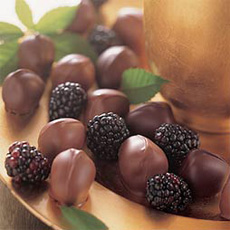 Enjoy the fruits of summer. Bissinger’s chocolate-covered blackberries are only available from August 22-September 15.
|
 |
Gourmet News Archives
August 2005
8.29.05
Doubly “Best In Show.” In a rare feat, a cheese from Wisconsin producer Uplands Cheese Company took top honors for the second time in the American Cheese Competition, winning the coveted “Best of Show” award. Their cheese, “Pleasant Ridge Reserve,” had first won Best of Show in 2001. As the competition alternates cities every year, it’s an added coincidence that both the 2001 and 2005 shows were held in Louisville, Kentucky. Pleasant Ridge Reserve won over 749 entries, a record-breaking number for the annual 22nd Annual Competition and Judging.
Pleasant Ridge Reserve, a farmstead cheese, has been made for only five years, making the two-time Best of Show win an especially remarkable feat (its first win was in its debutante year). Of continuing noteworthiness is that Uplands Cheese Company owners Mike and Carol Gingrich only took up cheesemaking and farming as a second career, begun in semi-retirement.
Pleasant Ridge Reserve is made only between May and October when the cows can graze on pasture. The Gingriches practice rotational grazing of their cows, which allows the cows to have a diet rich in grasses and herbs. By continually moving the cows to different parts of the pasture, rotational grazing also helps keep the land healthy; and obviously, the nutritious pasture creates unique flavors in the milk, which translate to the cheese.
Some other winners in this year’s competition include:
- Cheddar Aged Between 12 and 24 Months: California’s Fiscalini Cheese Company
- Cheddars Aged Less than 12 Months: Wisconsin’s Carr Valley Cheese Company for its Mammoth Cheddar
- Cheddars Aged Over 49 Months: Wisconsin’s Widmer Cheese Cellars for its 6-Year Cheddar
- Blue Cheese: Vermont’s Boucher Farm for its gorgonzola-style Gore-Dawn-Zola
- Soft-Ripened Category: Vermont’s Jasper Hill Farm for cow’s milk, Louisiana’s Bittersweet Plantation Dairy for goat’s milk, and Old Chatham Sheepherding Company in New York State for sheep’s milk
- American Originals (cheeses invented by the cheesemaker): California’s Three Sisters Farmstead Cheese Company for their Bella Sorella cow’s milk cheese; California’s Cypress Grove Chevre for their Humboldt Fog Mini goat’s milk cheese; and Wisconsin’s Carr Valley Cheese Company for their Menage sheep’s milk cheese.
There are 23 main competition categories in the annual competition, and several sub-categories. The entrants were from the United States and Canada. A complete list of competition winners can be downloaded at the American Cheese Society website, cheesesociety.org. Pleasant Ridge Reserve can be purchased from Murray’s Cheese. It’s not on their website as of this writing, but you can call 1.888.692.4339 x 7. The cheese is $26.99 a pound plus shipping.
It’s Green Tea Time for Charbay Vodka. Climbing on the green tea bandwagon is Charbay Green Tea Vodka, an elegant sipping vodka distilled with four select green tea varieties from China's Anhwei province. Master Distiller Miles Karakasevic sought out teas that would give the vodka a top-note, middle structure and long, smooth base finish similar to a perfume.
Charbay’s regular vodka was named Food & Wine Vodka of the Year in 2003 and Spirit Journal's #1 Vodka in the World in 2004. Along with the green tea flavor they released a raspberry-flavored vodka.
Is green tea vodka a significant flavor enhancement or just capitalizing on a trend? Given how many green tea cocktails are popping up on fashionable drink menus across America, it certainly meets a current need in the marketplace: no need for mixologists to infuse their own or use green tea extracts. |
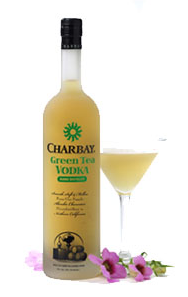 |
Are Tea Spirits a Trend? America’s love of chai continues to flourish: the market for chai teas has been growing at 50% annually. We’ve had everything from chai ice cream to chai crème brulée. When Starbucks is serving green tea chai latte, you know it’s mainstream. Now, there’s Voyant Chai Cream Liqueur, a delightful treat made of Virgin Island rum aged in oak casks, fresh Dutch cream, India black tea with chai spices (notably cinnamon, clove, ginger and vanilla), honey, and premium Dutch spirits. The Dutch cream is GBH and antibiotic free.
Rich and creamy like a dessert, drunk chilled and straight, Voyant Chai Cream is a lovely end to a meal, an accompaniment to afternoon tea, or a smooth, sweet treat instead of an ice cream. Many carb-conscious people steer clear of liqueurs, but a little taste goes a long way. The website has a few dozen recipes including a lamb stew with Voyant liqueur, fresh ginger and dried prunes. You can pour it on on top of vanilla ice cream as a dessert, or make an adult smoothie by blending it with crushed ice.
Legend tells that a king in the ancient courts of India invented chai 5,000 years ago. Considered by many in the east to be an aphrodisiac, it’s an appropriate gift for a romantic occasion, and an interesting hostess gift.
The terra cotta-colored bottle with lighter colors of persimmon and tangerine, plus a dark red, are appropriately spicy colors.
The 750-ml bottle is 25 proof (12.5% alcohol) and retails for about $24 at retail stores.
|
 |
8.22.05
Calorie-Free Flavor Mists Debut. For years, companies catering to dieters have sought to add flavor to humdrum foods. Now celebrity chef David Burke has tossed his toque into the ring, launching an extensive line of calorie-free David Burke Flavor Sprays™. Working with a flavor company and using top ingredients to achieve extracted flavor, foodies on diets—or just looking for some creative fun—can spritz flavor onto virtually every food they see during the day.
Conceptually, the Flavor Sprays work by satisfying a craving for flavor ordinarily provided by high-calorie gravies, dressings, and sauces, and toppings. “I created this unique line of flavor sprays so people can enjoy the tastes of all of their favorite foods without experiencing the guilt,” said Burke, partner and executive chef of the restaurant Davidburke and Donatella in New York City. “In all of my years of cooking and experimenting with spices, condiments, and flavors, I have never come across anything that can enhance the flavor of food this easily.”
Burke suggests a typical day of spritzing:
- For breakfast: Smoked Bacon spray on scrambled eggs.
- For lunch: a spray of Memphis Barbecue on baked chicken, a spray of Parmesan Cheese on steamed broccoli, a spray of Ranch on salad.
- For snacks: a spray of Mochaccino on rice cakes, a spray of Tomato Basil on celery or cucumbers.
- For dinner: a spray of Teriyaki on grilled steak, a spray of pesto on string beans, a spray of Parmesan on cauliflower, a spray of chocolate fudge on whipped topping.
Creative flavoring extends to spraying the rim of martini glasses with Pesto Spray or the rim of a cocoa cup with Marshmallow Spray. Kids can spray Root Beer Float or Strawberry Shortcake onto cereal and cookies, or enjoy eating their vegetables more with Sausage and Peppers Spray.
The flavor line-up includes:
- Savory sprays include Balsamic Spray*, Buttery Spray*, Parmesan Cheese Spray, Pesto Spray, Ranch Spray, Smoked Bacon Spray, Sour Cream and Onion Spray*, Tomato Basil Spray.
- Exotics include Hot and Sour Spray, Ice Blue Salt Spray, Memphis BBQ Spray, Mustard*, Pepper City Spray, Sausage and Peppers Spray* and Teriyaki Spray.
- Sweet and Sinful offers Banana Split Spray, Birthday Cake Spray*, Chocolate Crumb Spray*, Chocolate Fudge Spray, Cola Float Spray, Cookies & Cream Spray, Key Lime Pie Spray*, Marshmallow Spray, Mochaccino Spray, Pretzel Dough Spray*, Raspberry Bubblegum Spray, Root Beer Float Spray, Strawberry Shortcake Spray.
Asterisked flavors are coming soon, along with a line of fruit-flavored sprays.
The sprays are liquid extracts containing water, salts, emulsifiers and natural and artificial flavors; the sweet sprays contain Splenda®. They contain zero calories, zero fat, zero cholesterol, zero carbohydrates and FDA-approved flavoring. David Burke Flavor Sprays™ are sold online at www.flavorspraydiet.com. A two-ounce spray bottle costs $5.95. Kids will love spraying the sweeter flavors on their arms and licking it like candy. At these prices, hide the bottles on the top shelf. |
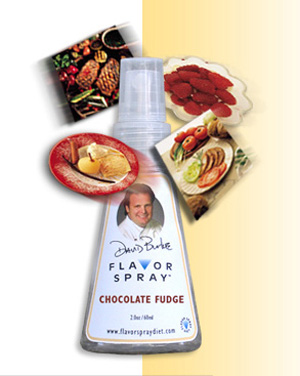 |
| Flavor Sprays are another innovation from creative star chef David Burke. |
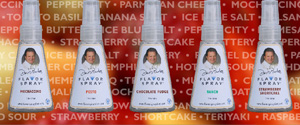 |
| Nineteen flavors are now available, soon to grow to 28. |
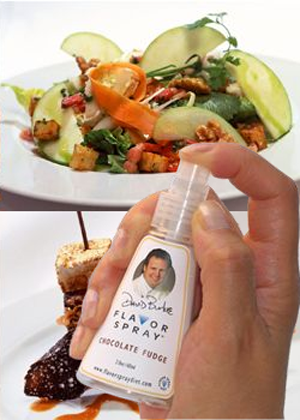 |
| Spritzing is not just flavorful—it’s fun! |
Wishbone Salad Dressing Also In Spray Mode. Wishbone’s new spray-on salad dressing will debut on The Apprentice next month—although what the two teams have to do with it is still under wraps. Two different flavors will enable consumers to use less salad dressing, since spraying uses much less product than pouring. If it takes off with diet-conscious consumers, Wishbone will be selling 1/3 less salad dressing for the same price, including the spray pump. By the way, we at THE NIBBLE have been spraying olive oil and blended salad dressings for years, after getting the idea from Pam® Cooking Spray and wanting a better tasting option with no aerosol propellants. It’s easy: just buy an empty 6-8 ounce spray bottle at a cooking or beauty products store, fill it, and spritz away. Heavy mayonnaise-based dressings may not pump through, but vinaigrettes work just great.
Sip For The Cure. The Republic of Tea continues to benefit the fight against breast cancer with a new limited edition bottled iced tea with healthful green tea properties: Sip for the Cure Pink Lemonade Iced Green Tea. The company will donate 10 percent of the sale of this limited release iced tea directly to the Susan G. Komen Breast Cancer Foundation. This unsweetened, organic, ready-to-drink iced tea will be available exclusively during National Breast Cancer Awareness Month, October. The bottled tea will join Sip for the Cure's other products:
The line includes four tea flavors and a marmalade, based on pink fruits blended with healthful green tea:
- Sip for the Cure Pink Grapefruit Green Tea and Sip for the Cure Pink Grapefruit Decaffeinated Green Tea (lively notes of sweet-tart pink grapefruit and peony flowers blended with crisp China green tea)
- Sip for the Cure Pink Rose Tea (delicate blossoms and petals lend an elegant floral note to the bright, fresh flavor of china green tea)
- Sip for the Cure Pink Lady Apple Green Tea (Pink Lady® apples are intensely sweet and succulent, and a natural counterbalance to healthful China green tea)
- Sip for the Cure Pink Lemonade Green Tea (tart-sweet pink lemonade combined with China green tea)
- Pink Grapefruit Tea Marmalade (a tropical tart and sweet marmalade, full of fruit and zest)
Tins of 50 bag tins are $10.00, a Traveler's Tin of 6 tea Pink Grapefruit Green Tea bags is $4.75, and Pink Grapefruit Tea Marmalade Tropical tart and sweet marmalade, is $7.75 for 13 ounces. Donations to the Susan G. Komen Breast Cancer Foundation range from 55 cents for the marmalade, 75cents for a tin of 50 bags and 36 cents for the Travelers Tin.
Republic of Tea also offers Man Kind Tea, a premium China green tea with blueberries for men’s prostate health, benefiting the Prostate Cancer Foundation. Blueberries and green tea both have anti-oxidants, which some research has shown to be beneficial in fighting prostate cancer—a disease which affects one out of six American men. As with Sip for the Cure, 75 cents of each tin of 50 bags is donated to the Prostate Cancer Foundation, a fundraising, support and advocacy group whose grants have been distributed to more than 1,200 researchers at 100 institutions worldwide.
The teas and marmalade are available at specialty food stores or at http://www.republicoftea.com.
For information about breast health or breast cancer:
- Call the Komen Foundation's National Toll-Free Breast Care Helpline at 1.800 I'M AWARE (1.800.462.9273)
For articles on green tea and prostate cancer:
- http://www.republicoftea.com/pages/mankind3.asp.
For foundations and organizations
- http://www.republicoftea.com/pages/mankind4.asp
|
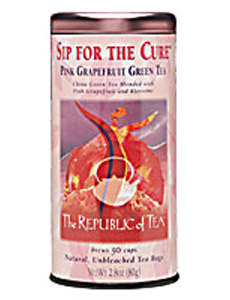 |
| Pink Grapefruit Green Tea |
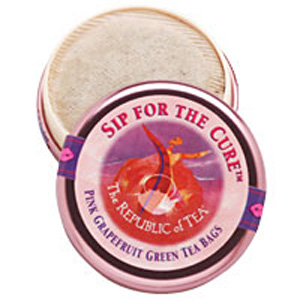 |
| Travel Tin. |
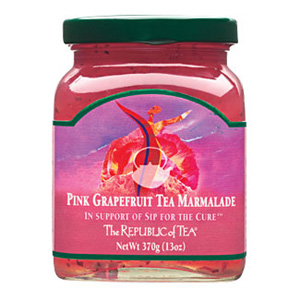 |
| Pink Grapefruit Green Tea Marmalade. |
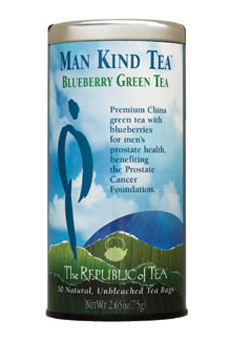 |
| Man Kind Tea, blueberry green tea. |
8.15.05
Better Than Sliced Bread. The world’s first “crustless bread,” an all-white sliced loaf with no brown crust, debuted August 10th in Great Britain. Launched by Hovis, a large commercial bread manufacturer, the loaf was developed after a survey revealed an amazing 67% of British children do not like crusts, 35% of parents cut the crusts off sandwiches before their children will eat them, and crust-cutting wastes up to 45% of the bread. Crusts are usually left in lunch boxes—83% of lunch boxes are usually returned three or four times a week containing discarded crusts.
Hovis Invisible Crust bread is made from regular ingredients, but is slowly cooked in a special tin and oven so that the outer layer of dough does not brown. The product was in development for two years and is made with a patented process. The cost is approximately $1.75 (99 pence) a loaf. The new loaf is all white, but it is not completely crust-free. There are faint, soft white crusts, but they have no distinctive taste.
Lisa McClean, a mother from east London, trims her children’s sandwiches, commenting “If I don’t do it, then they’ll just eat the white bits of the sandwiches and waste a lot of the filling.” She was impressed by the taste—no different from ordinary bread—and the fact that there’s no waste. Her 12-year-old daughter liked the taste. as well. Her 8-year-old son, who claimed he was less fussy than his sister, said: “It’s fine. I don’t really mind crusts, but this is OK.”
When asked what makes children discard the crusts, 29 percent of parents believed their children are fussy, while 19 percent attributed it to the taste. Some children resist crusts because of a myth that crusts make one’s hair curly. The bread was developed under the codename Project Curly.
Kids like it: Georgia McClean, 12, and her brother, Harry, 9. Photo by Photo by Heathcliffe O’Malley for the News Telegraph.
|

|
| Hovis Invisible Crust was unveiled at London's Dorchester Hotel. Pop singer Louise Redkapp poses with the wonder bread. Photo courtesy of Life Style Extra. |
 |
| Moms like it. Photo courtesy of The Telegraph, Calcutta, India. |

|
Toto, I Don’t Think We're in Nippon Anymore. Your deluxe sushi combo may soon soon be made with a combo of brightly colored wrappers made from vegetables and fruits instead of blackish-green toasted seaweed. An imaginative alternative to the traditional nori seaweed wrap, the nouvelle wrappers are undergoing final recipe formulations before being released to the marketplace.
The patent-pending wraps were developed by the U.S. Agricultural Research Service (ARS) scientists in partnership with Origami Foods, LLC. They developed dozens of tasty, colored wraps to use for sushi as well as hors d’oeuvres and desserts. Those passing muster in the test kitchens include:
- A cucumber and garlic filling on a nigiri rice pad, banded by a bright-orange carrot-based wrap
- Spicy tuna and rice in a deep-red tomato and basil wrap
- Thai curry sushi made—curry-seasoned potatoes, carrots, green onions and coconut milk—in the carrot wrap
- A rice and diced roast pork sushi rolled in a pineapple-apricot-ginger wrap
- A bite-sized quiche sushi of carrots, onions and asparagus in a broccoli wrap
- A mini-cheesecake in a blueberry or strawberry wrap.
Sushi means “vinegar rice” and refers to the special rice preparation used for sushi—not to the fish, vegetables, egg, or other ingredients. So, while an evolution from the traditional Japanese sushi concept—as are California rolls and specialty items like spicy tuna and Philadelphia rolls (smoked salmon and cream cheese)—as long as vinegar rice is used in the preparation, it is still sushi. Sushi is made in three forms: nigiri, on pads of rice; maki, or rolls; and temaki, hand rolls. Sashimi is sliced raw fish prepared without rice.
The wraps, which can be produced as soft, pliable sheets, are at least 75 percent vegetable or fruit, plus other nutritious natural ingredients.
The research team is fine-tuning different combinations of wrap flavorings and fillings, working with two well-known sushi chefs, and other food industry experts. While most Japanese restaurants observe tradition, there are “nouvelle” sushi bars and numerous mainstream restaurants and caterers that will welcome this new opportunity for creativity. Expect to see many delicacies shaped like sushi but embracing every food from goat cheese to crème caramel. Some chefs, especially those who have been using fruit leather to make “sweet sushi,”can’t wait for the product release.
|
 |
| Wraps being tested include spinach apple-cinnamon, red bell pepper, mango-orange, carrot-ginger, tomato-basil, broccoli, soybean, strawberry and peach—flanked by another spinach wrap. Photo courtesy Origami Foods LLC. |
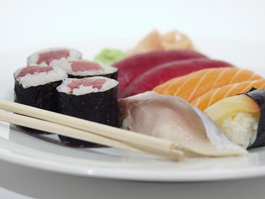 |
| Will the vegetable wrappers transform the classic sushi plate into nouvelle cuisine? |
| |
After Emu...Kangaroo? Kangaroo sausages are a hot item in Russia. According to a recent article in the Associated Press, Russia is the biggest export market for the meat and offal of the Australian marsupial, spending $11 million on the kangaroo meat products in 2004.
“Australia can't produce enough kangaroo meat,” Russian importer Igor Dorokhov told Australian Associated Press. “We need 100 containers per month; Australia can only produce 25.” Dorokhov, who specializes in game meats, said kangaroo was becoming popular as a cheap, red sausage meat among the eight million residents of Russia's remote far east. A Moscow-based Australian trade official said the scarcity of protein in the east was one explanation for the marsupial’s popularity in the region.
Emu and ostrich, which are related, flightless Australian birds, are farm-raised and have delicate-tasting meat that is growing in popularity as gourmet food products in the U.S. The kangaroo, a mammal, has a gamey taste and is apparently embraced for its low cost rather than its gourmet potential.
Some kangaroo meat is farm-raised and prepared by chefs at top restaurants. As with farm-raised venison and other raised game, the meat is tender and lacks the gaminess of an animal raised in the wild. |
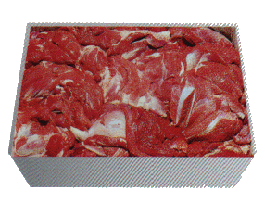 |
| Kangaroo meat. Photo courtesy of AussieGameMeats.com. |
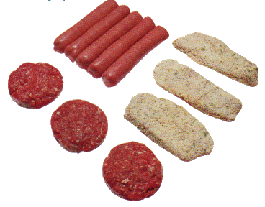 |
| Kangaroo sausages, burger patties, and crumb-coated steaks. Photo courtesy of AussieGameMeats.com. |
8.8.05
Battle of the Microbrewers: Bottles vs. Cans. Recently Jim Koch, a microbrewing industry pioneer and president of Boston Beer Co. which makes Samuel Adams, released his “Beer Drinker’s Bill of Rights.” One declaration: “Beer shall be offered in bottles, not cans, so that no brew is jeopardized with the taste of metal.”
Immediately called a “Bill of Wrongs” by Dale Katechis, owner of Oskar Blues Brewery in Lyons, Colorado, it precipitated a brew-ha-ha. Among other things, Katechis sent out a press release suggesting that Koch had been kidnapped by aliens. “Not only is the line about cans tasting like metal damaging to us,” said Katechis, “but it is also untrue.”
The sentiment was echoed by other boutique brewers, and also by the largest U.S. producer of beer. “We were shocked that he would make that statement,” said Doug Muhleman, group vice president for brewing operations and technology at Anheuser-Busch, of Koch's charge that cans can make beers taste metallic. “Obviously, he has some other agenda.”
Cans are the containers of choice in the mass beer market. While microbreweries have traditionally chosen bottles, in recent years a growing number of craft brewers have begun using cans because of improved technology that makes it cheaper and easier to package their products. Artisanal proponents of cans say aluminum gives their beer longer shelf life, protects it from light, and chills the product more quickly and keeps it colder longer. They dismiss Koch’s claims of metallic flavor, aluminum cans are lined with plastic precisely to prevent such an aftertaste. (Koch counters that although plastic protects the inside of the can, the tab and lip of the aluminum can—where the mouth comes into contact with the can and the beer—is not protected.
Koch puts his money where his mouth is. He has turned down millions of dollars in sales to airlines, stadiums, and golf courses that require cans and want to serve Sam Adams. “I wouldn’t have named my beer after a revolutionary if I was afraid of generating controversy over my principles,” he responded. “'I recognize others have different standards and may make compromises that I'm not willing to make.”
Beer has been made since pre-historic times. Until bottling technology was invented in the 19th century, consumption was limited to draft beer. Beer in cans was introduced in the 1930s; and a water-based plastic coating for cans replaced a solvent-based one in the 1980s. Since then, according to the Master Brewers Association of the Americas, studies have shown that there have been no detectable differences between canned and bottled beer. |
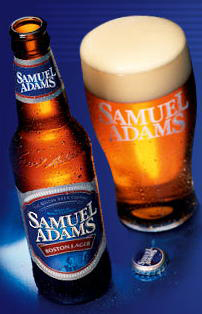 |
| Sam Adams: Turned down millions in sales rather than put beer in cans. |
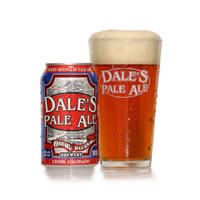 |
| Dale Katechis believes cans protect microbrews from light and oxidation, and make beer more portable in the great outdoors. Above, Oskar Blues Brewery’s Dale’s Pale Ale. Below, Old Chub Scottish-style ale with crystal, chocolate and beechwood-smoked malts. |
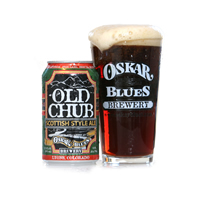 |
Lo Han Kuo: The “New” Low-Calorie Sugar Alternative. We recently were introduced to a new low-calorie sweetener, Lo Han Kuo (also spelled Lo Han Guo) at the Fancy Food Show. It is the primary sweetener in Sencha Green Tea mints. Lo Han Kuo is a perennial vine in the cucumber or melon family. It possesses high percentage of natural glucose and the fruits are extremely sweet. Extract from the dried fruit is 200-250 times sweeter than table sugar.
In southern China and other parts of Asia, lo han kuo has long been used in cooking as well as in medicine—as a palliative for cough, colds, sore throat, respiratory infections and upset stomach. It is called the “longevity fruit” in China because of its cooling, calming, stress-reducing effects. It is drunk as a tea, and available here in that form; as well as in powder and liquid forms for sweetening foods, cooking and baking (it is very stable under high temperatures). The extract has garnered interest in the Wet as an alternative sweetener: it has only 2 calories per portion and has a low glycemic index: it doesn’t cause spikes in blood sugar, so can be used by diabetics.
Lo han kuo was discovered on an agricultural expedition by an Western botanist, Professor George Weidman Groff, in 1932. He requested requested a grant from the National Geographic Society to discover where it and how it was cultivate. The scientific name, Momordica grosvenori, is in honor of Gilbert H. Grosvenor, a former president of the National Geographic Society, who first brought the fruit to the attention of scientists in the United States. The latest medical research is being conducted mostly in China and Japan. Results from preliminary lab and animal testing suggest that certain compounds in M. grosvenori act as antioxidants and might help prevent tumor growth. The fruit and its extract haven’t been well studied in humans, so it's too early to assess their effectiveness in preventing diabetes or assisting with weight loss. |
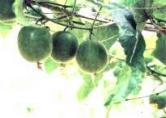 |
| Lo han kuo growing on the vine. |
 |
| Ripe fruit. |
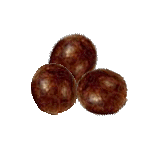 |
| Dried fruit. |
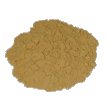 |
| Extract in powder form. |
Is Green Tea the New Chipotle? Specialty teas are hot with U.S. consumers, who are venturing far from their traditional supermarket tea bags and buying more“exotic” tea blends, fueling a $6.8 billion domestic tea market. According to a new report from market research publisher Packaged Facts, a division of MarketResearch.com, the tea market will reach $10 billion by 2010.
Although we began as a British colony, tea in the United States has never had the popularity of coffee, nor do Americans drink as much tea as consumers abroad. Most of the U.S. retail tea sales are ready-to-drink bottled and canned ice teas.
Green and white teas, however, have given a shot in the arm to the industry. As Americans espouse health-conscious foods and the health properties of green and white teas become more widely publicized, tea has become hot. As traditional black tea sales decline, specialty tea sales continue to grow. As manufacturers strive to ride the trend they include green tea in ice creams, puddings, cakes, muffins, candies, cocktails, sodas, lattes, and a host of cosmetics, health and beauty aids.
White tea, shown to have substantially higher levels of antioxidants than green tea, is not expected to have the same trajectory as green tea, since it’s significantly more expensive and the flavor is very subtle. |
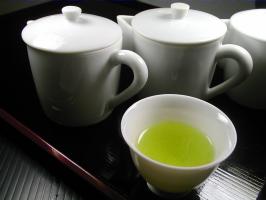 |
| Green tea. Photo courtesy of JapaneseGreenTeaOnline.com. |
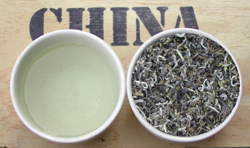 |
| White tea. Photo courtesy of SVTea.com. |
8.1.05
Chipotle Is Hot. A few years ago, chipotle chiles were virtually unknown outside of Mexico and the Tex-Mex cuisine of the Southwestern United States. Now, chipotle seems ubiquitous in fine food circles, from condiments on the shelves of specialty food shops to seasonings of the most traditional foods (click here to read our review of Rogue Creamery’s Chipotle Cheese Curds) to main courses at the toniest restaurants. Some are calling chipotle the “flavor of the decade.”
The chipotle (pronounced chih-POHT-leh) is a smoke-dried red jalapeño. It has wrinkled reddish to brown to dark brown skin and a flavor that’s smoky and slightly sweet. The most commonly smoked chiles are jalapeños, named for the city of Jalapa in the state of Veracruz.
The use of chipotle chiles dates back to the time of the Aztecs. The name for the chile more correctly is chilpocle, which comes from the Aztec language, Nahuatl, and the words chil for chile and pectli for smoke. The word was apparently reversed: it originally was spelled pochilli. Other early spellings in Mexico are tzilpoctil, tzonchilli, and texochilli.
The chile is available dried, canned in adobo sauce, pickled or as an ingredient in myriad condiments. Versatile chipotle can add flavor to foods from mayonnaise for It also adds a smoky depth to soups, stews, marinades and to traditional tacos, beans, stuffed peppers and moles. A popular new use is in chocolate bars and chocolate desserts. Chipotle, may not be the spice of life, but it certainly is one of them.
|
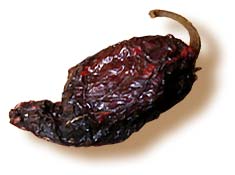 |
| Chipotle |
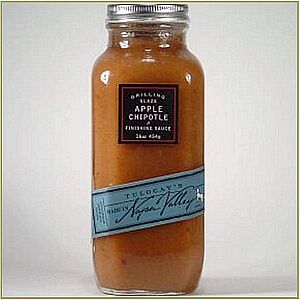 |
| Tulocay’s Apple Chipotle Finishing Sauce. |
Starbucks Water Has Noble Mission. Starbucks is now distributing “socially responsible” bottled water with the aim of helping to clean up the world’s water supply. Over the next five years, the aptly-named Ethos (“fundamental values”) bottled water is expected to generate enough sales, at five cents a bottle contribution, to enable the company to donate $10 million for clean-water sources in poor countries. The funds will go to non-profit organizations working in countries like Bangladesh, Democratic Republic of Congo, Ethiopia, Honduras, and Kenya.
Nearly 20% of the world’s people lack safe drinking water and about 4,500 children under age 5 die daily of resulting illness. Ethos’ mission is “Helping children get clean water.” (Although all members of the community benefit, the emotional tug of needy children has been found to promote more empathy and action.) The brand was started by two business executives after a trip by one to South Africa, and about $100,000 of its sales have been donated to water efforts by non-governmental organizations Unicef and Care. Starbucks bought the brand in April.
In addition to sales at Starbucks shops, Ethos can be purchased at many Whole Foods and at other food retailers. Starbucks plans to donate 5 cents per bottle of Ethos. The price at Starbucks stores is $1.80 for a 700 milliliter bottle. More information about the project can be found at http://www.ethoswater.com.
Transitioning from water for the very poor to Champagne for the very wealthy: |
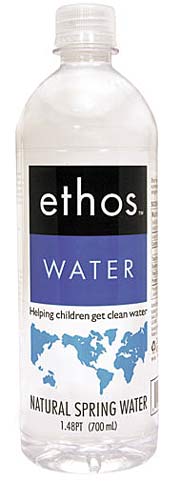 |
Moët et Chandon to Sell Vines. Moët et Chandon, whose flagship product is Dom Perignon champagne, has put 15 hectares of champagne vines up for sale in the departement of L’Aisne, where it has a total of 150 hectares. On average, a hectare produces 13,000 kilos of grapes, but only 4,000 kilos are judged to be the quality to be made into Champagne. They produce 2,550 liters of must, or unfermented grape juice, which is then turned into champagne. (The rules of the Champagne region allow 2,550 liters of juice from each 4,000kg of grapes—the cuvee—plus another 500 liters known as the taille, which can be turned into other wines.) The must then undergoes its first fermentation in large containers, where it becomes “base wine” and is stored until needed to make champagne. In vintage years, all base wine goes immediately into production to make that vintage year’s champagne. In a non-vintage year, a portion is reserved to blend with base wines from future years to create a consistent flavor. Dom Perignon is only made in vintage years (vintage years are declared by the governing council, not by the individual producer, based on the ripeness of the grapes and other factors).
By the way, the story of Dom Pierre Perignon “discovering” Champagne by accidentally creating bubbles in his wine, and then exclaiming, “I am drinking the stars,” is a fable. Dom Perignon was a wine-maker from 1668 to 1715 at the Abbey of Hautvillers, located near Epernay in Champagne. His significant contribution was the art of improving the product by blending wines from grapes grown in various parts of Champagne. The story was popularized more than 100 years later, in 1821, by a monk at the abbey named Dom Grossard. Moet et Chandon named its prestige cuvee after Dom Perignon in 1937.
Another fun champagne fact: the cork, although mushroom-shaped when removed, is actually a cylinder like any other wine cork (just wider and longer to accommodate the larger bottle mouth). The pressure in the champagne bottle has distorted its shape. If you soak a champagne cork in water for a few days, it will revert to its original shape.
|
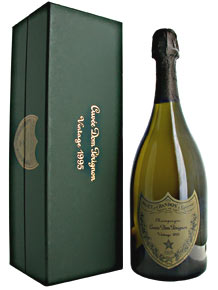 |
| Above, Dom Perignon 1995. Below, a cork shaped by pressure into a “mushroom.” |
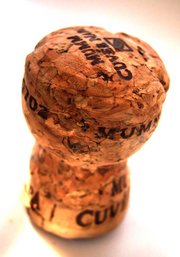 |
Taittinger About To Flip. Last month, another beloved Champagne made news when Greenwich, Connecticut-based real estate buyout house Starwood Capital Group LLC bought the Taittinger business. On July 22, the property investment fund purchased a 65% stake in Taittinger SA and 65.3% of its subsidiary, Paris-based Société du Louvre SA, in a deal valuing the two businesses at €2.86 billion. Starwood immediately announced that it would flip the Champagne business and that it was consulting with the Taittinger family on a potential sale.
The Taittinger family and billionaire Belgian financier Albert Frère, are lining up bids. Taittinger family members are looking to take a minority stake. Frère, who owned a 25% stake in Taittinger and a 15% stake in Société du Louvre, last week declared his interest and suggested he would consider a consortium bid with Taittinger family members and France’s Peugeot family. French spirit maker Pernod Ricard SA, which last month completed its $13.25 billion takeover of U.K. rival Allied Domecq PLC may also be a potential bidder.
The company is expected to fetch close to €600 million ($731 million) when it goes on the block in mid-September — just over a month and a half after purchased it. Starwood has said it would be willing to sell the business for the price it paid, estimated to be about €420 million, and an additional €165 million in assumed debt, and that it would favor a French buyer. |
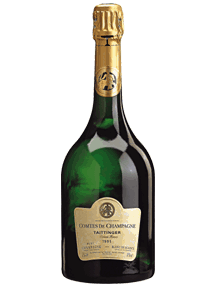 |
| Taittinger is the world’s Number 6-ranked champagne brand. The Comtes de Champagne, above, is a tête de cuvee (top of the line) wine made only in vintage years from the finest grapes. |
Lifestyle Direct Direct, Inc. All rights reserved. Images are the copyright of their respective owners.

|




 Enjoy the fruits of summer.
Enjoy the fruits of summer. 





























